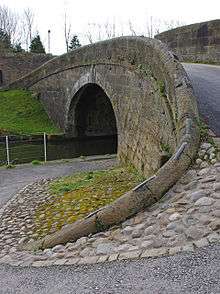Coping (architecture)
Coping (from cope, Latin capa) consists of the capping or covering of a wall.[1]

A splayed or wedge coping slopes in a single direction; a saddle coping slopes to either side of a central high point.[2]
A coping may consist of stone (capstone), brick, clay or terracotta, concrete or cast stone, tile, slate, wood, thatch, or various metals, including aluminum, copper, stainless steel, steel, and zinc.[3] In all cases it should be weathered (have a slanted or curved top surface) to throw off the water.[1]
Various types of copings exist. A diagrammatic explanation of copper copings is available.[4][5][6]
In Romanesque work copings appeared plain and flat, and projected over the wall with a throating to form a drip. In later work a steep slope was given to the weathering (mainly on the outer side), and began at the top with an astragal; in the Decorated Gothic style there were two or three sets off; and in the later Perpendicular Gothic these assumed a wavy section, and the coping mouldings continued round the sides, as well as at top and bottom, mitring at the angles, as in many of the colleges at Oxford.[1]
See also
References
-

- Ching, Francis D. K. (1995). A Visual Dictionary of Architecture. Van Nostrand Reinhold Company. ISBN 0-442-02462-2, p. 266.
- "Types of Wall Coping". Roof Online. Retrieved 2019-03-15.
- Flashings and copings: Coping covers; http://www.copper.org/applications/architecture/arch_dhb/flashings_copings/coping_covers.html
- Flashings and coatings: Counterflashing; http://www.copper.org/applications/architecture/arch_dhb/flashings_copings/counterflashing.html
- Flashings and copings: Stepped and chimney flashings